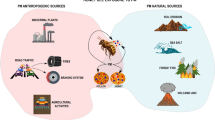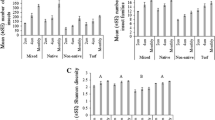Abstract
Analysis of pollen–spore spectra from spider webs collected from three different places of Santiniketan, Birbhum District, West Bengal was undertaken to study the airborne pollen–spore and vegetation pattern. A total of 15 spider web samples were collected from the study sites. The pollen and spores were retrieved from the spider web samples based on standardized laboratory procedures with hydrofluoric acid (HF) and acetolysis method. A total of 3601 pollen–spore were retrieved from the samples among which 36 taxa belonging to 27 families of angiosperms, 13 fungal taxa belonging to 10 families and 1 pteridophytic taxon representing 1 family were recorded. The recovered pollen and spore count showed tree taxa (45.90%) were the most dominant, whereas shrubs (1.53%), herbs (31.69%), pteridophyte (0.57%), and fungal spores (20.35%) were also present in the pollen and spore rain of different sites. The pollen grains of taxa, such as Holoptelea integrifolia, Senna siamea, species of Syzygium, Azadirachta indica, Borassus flabellifer, Aegle marmelos, species of Phyllanthus, Ailanthus excelsa, Parthenium hysterophorus, Tridax procumbens and Poaceae were found most commonly in all three sites. Fungal spores of Alternaria, Aspergillus, Cladosporium, Curvularia, Nigrospora were found in moderate (18–20%) frequencies among total pollen–spore count. The study reveals that spider webs act as an effective cost-less natural sampler for analysis of airborne pollen–spore and vegetation patterns.








Similar content being viewed by others
References
Lacey J (1991) Aerobiology and health: the role of airborne fungal spores in respiratory diseases. In: Frontiers in mycology, fourth international mycological congress, Regensberg, pp 157–185
Edmonds RL (1979) Aerobiology: the ecological systems approach. UWBP Synth. Scr. 10. Dowden. Hutchinson & Ross Inc., Stroudsburg
Jantz N, Homeier J, León-Yánez S, Moscoso A, Behling H (2013) Trapping pollen in the tropics—comparing modern pollen rain spectra of different pollen traps and surface samples across Andean vegetation zones. Rev Palaeobot Palynol 193:57–69. https://doi.org/10.1016/j.revpalbo.2013.01.011
Prentice IC (1985) Pollen representation, source area, and basin size: toward a unified theory of pollen analysis. Quat Res 23:76–86. https://doi.org/10.1016/0033-5894(85)90073-0
Groenman-vanWaateringe W (1998) Bark as a natural pollen trap. Rev Palaeobot Palynol 103:289–294. https://doi.org/10.1016/S0034-6667(98)00040-2
Bera SK, Trivedi A, Sharma C (2002) Trapped pollen and spores from spider webs of Lucknow environs. Curr Sci 83:1580–1585
Song XY, Blackmore S, Bera S, Li CS (2007) Pollen analysis of spider webs from Yunnan, China. Rev Palaeobot Palynol 145:325–333. https://doi.org/10.1016/j.revpalbo.2007.01.001
Zhang ZY, Yang FC, Cheng DM, Ferguson DK, Hu W, Li YZ, Li CS (2020) Comparison between two kinds of natural pollen traps in tropical China: ants’ nests on tree branches versus surface soil. Palynology 44(1):4–11. https://doi.org/10.1080/01916122.2018.1549117
Quamar FM, Chauhan MS (2011) Pollen analysis of spider webs from Khedla village, Betul District, Madhya Pradesh. Curr Sci 101:1586–1592
Hose GC, James JM, Gray MR (2002) Spider webs as environmental indicators. Environ Pollut 120:725–733. https://doi.org/10.1016/S0269-7491(02)00171-9
Quamar FM, Bera SK (2016) Pollen analysis of spider web samples from Korba District, Chhattisgarh (central India): an aerobiological aspect. Aerobiologia 32:645–655. https://doi.org/10.1007/s10453-016-9438-2
Karak P, Bhattacharya K (2014) Airborne fungal spore load in Santiniketan, West Bengal with reference to respiratory allergy. Indian J Aerobiol 27:20–25
Basak T, Chakraborty A, Bhattacharya K (2017) Pollen spectrum variations in the atmosphere of Santiniketan, West Bengal and influence of meteorological parameters & air pollution. Indian J Sci Res 17:01–12
Erdtman G (1960) The acetolysis method. A revised description. Sven Bot Tidskr 54:561–564
Erdtman G (1943) An introduction to pollen analysis. Read Books Ltd, Waltham
Gregory PH (1973) Microbiology of the atmosphere, 2nd edn. Leonard Hill, Aylesbury
Satheeshkumar S, Vittal B (1998) A preliminary survey of airborne pollen in Madras City. Aerobiologia 14:69–73. https://doi.org/10.1007/BF02694597
Bhattacharya A, Mondal S, Mandal S (1999) Entomophilous pollen incidence with reference to atmospheric dispersal in eastern India. Aerobiologia 15:311–315. https://doi.org/10.1023/A:1007690128025
Reddi CS, Reddi NS (1986) Pollen production in some anemophilous angiosperms. Grana 25:55–61. https://doi.org/10.1080/00173138609429933
Gioulekas D, Balafoutis C, Damialis A, Papakosta D, Gioulekas G, Patakas D (2004) Fifteen-year records of airborne allergenic pollen and meteorological parameters in Thessaloniki, Greece. Int J Biometeorol 48:128–136. https://doi.org/10.1007/s00484-003-0190-2
Mondal S, Bhattacharya KN, Mandal S (1997) Observations on pollen anthesis and dispersal of certain angiosperms. In: Agashe SN (ed) Aerobiology. Oxford and IBH Pub Pvt. Ltd. Co., New Delhi., pp 401–405
Agashe SN (1989) Airborne entomophilous pollen—potential source of allergy. In: Tilak ST (ed) Recent researches in ecology, environment and pollution. Today & Tomorrow's printers and publishers, New Delhi, pp 153–157
Mangla Y, Tandon R (2011) Insect facilitate wind pollination in pollen limited Crateva adansonii (Capparaceae). Aust J Bot 59:61–69. https://doi.org/10.1071/BT10174
Taketomi EA, Sopelete MC, Moreira PF, Vieira FD (2006) Pollen allergic disease: pollens and its major allergens. Braz J Otorhinolaryngol 72:562–567. https://doi.org/10.1016/S1808-8694(15)31005-3
Garcia-Mozo H (2017) Poaceae pollen as the leading aeroallergen worldwide: a review. Allergy 72:1849–1858. https://doi.org/10.1111/all.13210
Horner WE, Helbling A, Salvaggio JE, Lehrer SB (1995) Fungal allergens. Clin Microbiol Rev 8:161–179. https://doi.org/10.1128/cmr.8.2.161
Lehrer SB, Aukrust L, Salvaggio JE (1983) Respiratory allergy induced by fungi. Clin Chest Med 4:23–41. https://doi.org/10.1016/S0272-5231(21)00181-7
Southworth D (1974) Introduction to the biology of airborne fungal spores. Ann Allergy 32:1–22
Ahlawat M, Chaudhary D, Dahiya P (2014) Allergenic pollen in the atmosphere of Rohtak city, Haryana (India): a pioneer study. Aerobiologia 30:229–238. https://doi.org/10.1007/s10453-013-9323-1
Acknowledgements
The authors are thankful to the UGC Non-NET fellowship for financial assistance and the Department of Botany (DST-FIST & UGC-SAP, DRS) Visva-Bharati, for providing necessary laboratory facilities.
Author information
Authors and Affiliations
Corresponding author
Ethics declarations
Conflict of interest
The authors declare that they have no conflict of interests.
Additional information
Publisher's Note
Springer Nature remains neutral with regard to jurisdictional claims in published maps and institutional affiliations.
Significance Statement
Spider web as a natural trap showed promising results for evaluation of airborne allergic pollen–spores which will also help to indicate the floristic composition.
Rights and permissions
About this article
Cite this article
Oraon, S., Pal, S., Bhandari, P. et al. Spider Web: A Natural Sampler for Analysis of Airborne Pollen–Spores from Santiniketan, West Bengal. Proc. Natl. Acad. Sci., India, Sect. B Biol. Sci. 92, 919–927 (2022). https://doi.org/10.1007/s40011-022-01383-x
Received:
Revised:
Accepted:
Published:
Issue Date:
DOI: https://doi.org/10.1007/s40011-022-01383-x




